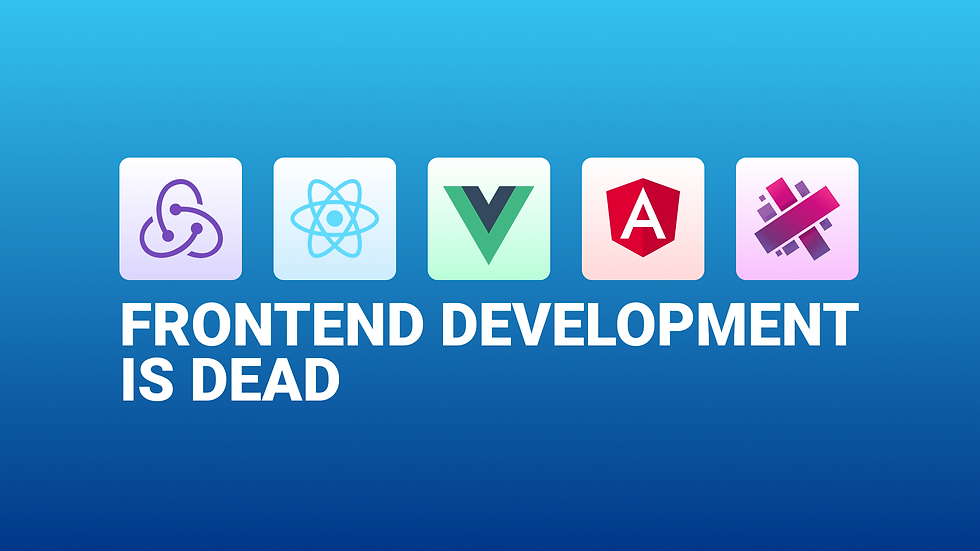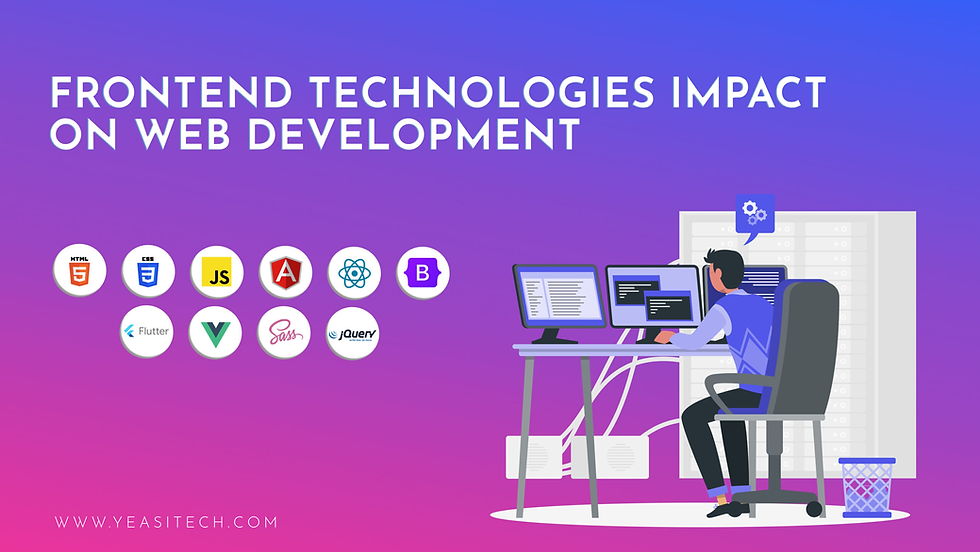Is Frontend Engineering Dying? Analyzing Trends and Future Prospects
- Jayant Upadhyaya
- Jul 23
- 8 min read
Updated: Aug 23

Frontend engineering is often questioned in today’s rapidly evolving tech landscape, with some arguing that it is becoming obsolete. However, this view overlooks the significant transformations the field is undergoing rather than a decline. Frontend engineering is not dying; it is evolving to meet new technological challenges and user expectations.
As technologies such as AI, no-code platforms, and advanced frameworks emerge, the role of frontend developers shifts toward creating more dynamic, interactive, and immersive user experiences. The demand for skilled frontend engineers persists, but the required skillsets now include a broader mix of tools and deeper integration with backend systems.
This ongoing evolution means that frontend engineering remains a critical and vital part of software development, adapting rather than shrinking. Developers who stay current with trends and technologies will find ample opportunities in the field.
Understanding Frontend Engineering Dying

Frontend engineering involves creating the parts of software that users see and interact with directly. It requires technical skills, an understanding of design principles, and the ability to work with various tools and frameworks.
The role covers building user interfaces, ensuring responsive design, and optimizing performance. It demands continuous learning to keep up with evolving technologies and user needs.
Definition of Frontend Engineering
Frontend engineering focuses on developing the client side of web applications—the elements visible to users in their browsers. This includes designing and coding layouts, interfaces, and interactive features.
It bridges design and development by translating visual concepts into functional code. Frontend engineers work primarily with HTML, CSS, and JavaScript but also utilize frameworks like React, Vue, or Angular.
Their goal is to create seamless, accessible, and efficient user experiences that function across devices and browsers.
Core Responsibilities of Frontend Engineers

Frontend engineers build, maintain, and optimize the user-facing parts of websites and applications. This includes coding interfaces, integrating APIs, and testing for usability and accessibility.
They ensure applications run smoothly on different devices by implementing responsive design techniques. Performance optimization, such as reducing load times and improving rendering speed, is a critical task.
Collaboration with designers, backend developers, and product teams is essential to align functionality with product requirements and user expectations.
Required Technical Skills
Frontend engineers must master HTML, CSS, and JavaScript as foundational technologies.
Proficiency with modern JavaScript frameworks like React, Vue, or Angular is crucial for building complex interfaces.
They also need to understand toolchains and build systems, including Webpack and Babel, along with version control using Git.
Knowledge of UI/UX principles, cross-browser compatibility, accessibility standards (like WCAG), and responsive design is equally important.
Familiarity with APIs, testing frameworks, and performance optimization completes the skill set needed to succeed in this evolving field.
Market Trends in Frontend Development
Frontend development continues to evolve with strong demand driven by new technology adoption, shifting hiring priorities, and sector-specific growth. Developers must keep pace with changes like AI integration and full-stack collaboration to remain relevant.
Demand for Frontend Engineers in 2025
The need for frontend engineers remains steady in 2025, fueled by ongoing web and mobile app development. Companies increasingly seek professionals skilled in modern JavaScript frameworks, server-side rendering, and AI-enhanced tooling.
AI tools from studios like SynergyLabs in India are influencing expectations, requiring developers to combine UI expertise with automation knowledge. Demand is no longer limited to pure frontend tasks; developers who understand backend processes and performance optimization are favored.
Markets emphasize developers who build seamless user experiences while improving efficiency using emerging tech. This evolution reflects a shift toward more complex, integrated roles rather than a decline in need.
Hiring Patterns and Salary Trends
Hiring focuses on engineers with versatility across frontend stacks and AI collaboration capabilities. Companies prioritize candidates proficient in React, Vue.js, or Angular combined with skills in server-side rendering or static site generation.
Salary growth remains positive due to a competitive market, particularly in regions investing heavily in tech innovation such as India, Europe, and North America. Firms offer bonuses and remote work flexibility to attract top talent.
Freelance and contract roles have increased as organizations look for project-based expertise, especially for rapid AI-driven UI updates. This shift demands adaptability but also expands opportunities outside traditional employment.
Region | Average Salary Growth (2024-2025) | Demand Level | Notable Hiring Focus |
India | 10-15% | High | AI-integrated frontend roles |
North America | 8-12% | Very High | Full-stack and UI/UX combined |
Europe | 7-10% | High | Performance optimization |
Sector Focus: Logistics, E-commerce, and Fintech
Logistics companies require frontend engineers to build real-time tracking dashboards and user-friendly portals, prioritizing performance and scalability. AI-powered interfaces optimize routing and management, as seen with startups collaborating with AI studios like SynergyLabs.
E-commerce platforms depend on dynamic, personalized user experiences. Frontend developers must integrate AI recommendation engines, fast checkout flows, and progressive web app capabilities. These sectors emphasize frontend roles that drive direct business roi through improved usability and speed.
Fintech demands secure, interactive interfaces with complex data visualizations. Frontend engineers work alongside AI teams to implement fraud detection alerts and automated financial insights. The growing fintech market intensifies the need for developers versed in security compliance and rapid UI updates.
Technological Advancements Affecting Frontend Engineering

Modern frontend engineering is influenced by automation, interactive development platforms, and the integration of machine learning. These advancements reshape how developers create, manage, and optimize user interfaces and experiences.
AI-Powered Tools and Automation
AI-powered tools are automating routine frontend coding tasks such as code generation, bug detection, and performance optimization. Developers now leverage intelligent assistants that suggest code snippets or fix errors in real-time, improving efficiency.
Companies like SynergyLabs in India focus on AI-driven software solutions that aid in streamlining frontend workflows. These tools reduce manual overhead and allow developers to focus on complex design and functionality challenges.
Automation also supports responsive design testing across devices and browsers, speeding up deployment. AI’s role is not to replace frontline engineers but to augment their work by handling repetitive tasks.
Rise of No-Code and Low-Code Platforms
No-code and low-code platforms empower non-developers to build web interfaces and applications rapidly using drag-and-drop components and pre-built modules. This shifts some frontend production outside traditional engineering teams.
However, these platforms often serve as starting points. Experienced frontend engineers continue to refine and extend these builds with custom code for advanced features and better performance.
The growth of such platforms pressures frontend developers to integrate with and customize no-code outputs. Mastery of these tools combined with traditional coding skills is becoming valuable in the evolving landscape.
ML/ML Ops in Frontend Development
Machine learning (ML) integration in frontend development supports adaptive user experiences and personalized content delivery. Models analyze real-time user behavior to dynamically adjust interfaces, improving engagement.
ML Ops frameworks enable efficient deployment, monitoring, and updating of these models on the frontend, ensuring consistent performance. Frontend engineers increasingly collaborate with data teams to implement and maintain these systems.
This shift requires frontend developers to gain competencies in ML model handling and performance tuning, blending AI operations with user-centric design for improved application intelligence.
Changing Role of the Frontend Engineer
Frontend engineering now requires a blend of evolving technical skills, broader development knowledge, and a deep understanding of user experience. The role goes well beyond building interfaces to include integration with backend technology and creating intuitive, accessible designs.
Evolution of Responsibilities
Frontend engineers today handle more complex tasks than writing HTML, CSS, and JavaScript. They implement advanced frameworks, optimize performance across devices, and ensure accessibility compliance. This requires familiarity with build tools, testing, and deployment pipelines, moving them closer to DevOps practices.
They also work with AI-powered tools to automate repetitive tasks, boosting productivity without sacrificing quality. For example, companies like SynergyLabs in India adopt AI to streamline frontend workflows, reducing manual coding.
This shift means frontend engineers contribute to the entire product lifecycle, not just the user interface. As websites and apps become more dynamic, their role adapts to support rich, interactive experiences.
Full-Stack Development Integration
The boundary between frontend and backend development is increasingly blurred. Many frontend engineers acquire backend skills, enabling them to build full-stack applications independently or collaborate more effectively with backend teams.
This integration involves understanding APIs, server-side programming, databases, and cloud services. Full-stack familiarity helps engineers optimize data flow and functionality from the server to the user interface.
Employers often prioritize developers who can navigate both ends of the stack, as this reduces handoff delays and improves development speed. This broader skill set is now a key asset in the competitive job market.
Importance of UX/UI Expertise
Frontend engineers must not only code but also ensure designs are user-friendly and accessible. Their work directly impacts usability and customer satisfaction, making familiarity with UX/UI principles essential.
They collaborate closely with designers and product managers to translate wireframes and prototypes into functional interfaces. Accessibility standards such as WCAG guide their decisions to reach diverse audiences, including users with disabilities.
Understanding user behavior and interaction patterns helps engineers anticipate issues and enhance performance. This focus on experience aligns technical execution with business goals, increasing product success.
Industry Case Studies
Frontend engineering remains vital across diverse industries by enabling advanced interfaces and seamless user experiences. The following examples demonstrate its role in AI-driven analytics, custom application development, and agile product discovery, illustrating how frontend technologies adapt and integrate into complex projects.
The Impact of SynergyLabs in AI-Powered Video Analytics
SynergyLabs, based in India, specializes in combining AI with sophisticated software solutions. Their work on AI-powered video analytics platforms highlights frontend engineering’s role in delivering real-time, interactive dashboards. These interfaces allow users to monitor and analyze video feeds with rich visual data representation, improving decision-making processes.
The frontend team integrates technologies like React and WebSockets to handle high-performance data updates. This ensures that video data streams and AI insights are both accessible and user-friendly. SynergyLabs’ approach reflects how frontend development supports specialized AI applications, maintaining responsiveness and clarity in complex environments.
Custom Software Development for Modern Applications
Modern software relies heavily on customized frontend solutions to meet specific client needs. Frontend engineers build scalable, modular UI components that adapt to changing business goals and user feedback. These solutions often employ frameworks such as Vue.js or Angular to accelerate development while maintaining code quality.
Custom frontends also prioritize cross-device compatibility and accessibility, which are critical for today’s applications. By focusing on user-centric design and performance optimization, teams ensure the software not only functions well but provides a smooth experience for varied user bases.
Agile Consultancy in Product Discovery
Agile consultancy firms emphasize iterative frontend development during product discovery. This practice allows rapid prototyping and early user testing of visual elements, ensuring alignment with market needs. Frontend engineers collaborate closely with designers and product managers, refining UI based on feedback cycles.
Such consultancies rely on frontend tools that support flexibility, like Storybook for UI component libraries and automated testing frameworks. This integration helps reduce risk and accelerate time to market, demonstrating frontend engineering’s strategic role beyond coding—contributing directly to product success.
Future Outlook for Frontend Engineering

Frontend engineering is evolving with new technologies and shifting business needs. Developers will need to adapt to changes such as AI integration, platform specialization, and emerging markets. These shifts create specific challenges and opportunities that will shape the field's trajectory.
Predictions for the Next Decade
Frontend engineering will increasingly integrate AI tools to automate routine coding tasks and optimize user experiences. This will require developers to develop skills in AI collaboration rather than purely manual coding.
The rising importance of accessibility, performance, and scalability will push frontend engineers to focus on efficient, user-centric design. Platforms like Shopify will become critical knowledge areas, especially as e-commerce dominates frontend use.
Companies like SynergyLabs in India are already combining AI research with software development to build smarter, faster frontend applications. Developers who embrace continuous learning and cross-disciplinary skills will remain essential.
Emerging Opportunities in SaaS and Mobile Apps
The growth of SaaS and mobile app markets opens new frontend roles focused on real-time, responsive interfaces. Frontend engineers will build modular, reusable components tailored for diverse platforms and devices.
No-code and low-code platforms will shift some traditional frontend work but will also demand engineers who can extend these platforms with custom solutions.
Front-end teams will increasingly collaborate with backend, AI, and UX specialists, requiring both technical and communication skills. This holistic approach will be key in startups and established firms where efficiency and innovation matter.
Conclusion
Frontend engineering is not dying but evolving. The role continues to adapt as technologies and user expectations shift.
Developers are increasingly expected to have broader skill sets. Many move toward full-stack capabilities, balancing front-end and back-end knowledge to remain competitive.
No-code platforms and automation tools affect some traditional tasks but do not eliminate the need for skilled frontend professionals. Creative problem-solving and user experience design remain core strengths.
Demand for frontend engineers persists in industries driven by digital presence. Web interfaces and applications still require specialized development to deliver efficient, accessible, and engaging experiences.
Key insights for frontend engineers today:
Stay updated with emerging frameworks and tools
Develop cross-disciplinary skills
Focus on performance and usability
Embrace ongoing learning and adaptation
The future of frontend engineering involves continuous change, but its foundational importance to web development remains steady.






Comments